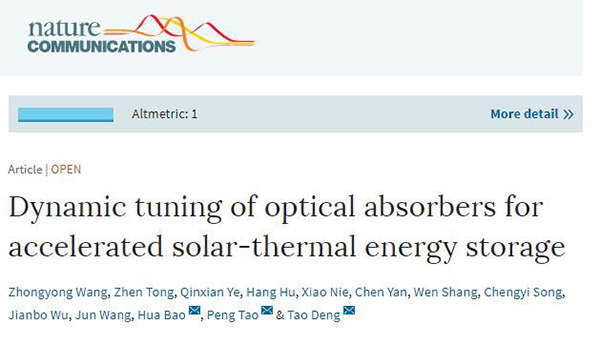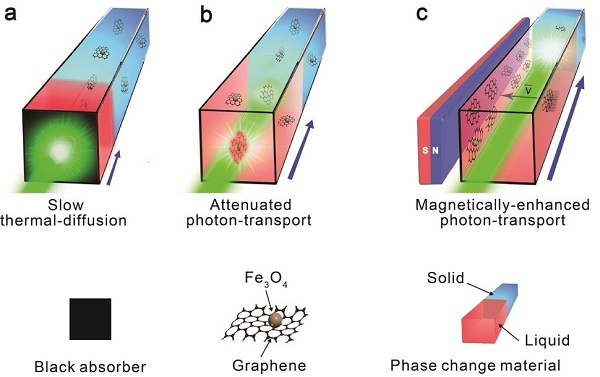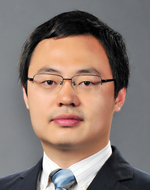The research teams of University of Michigan- Shanghai Jiao Tong University Joint Institute (UM-SJTU JI) Professor Hua Bao and Professor Tao Zheng of SJTU School of Materials Science and Engineering have recently co-published a paper titled “Dynamic tuning of optical absorbers for accelerated solar-thermal energy storage” in the internationally acclaimed academic journal “Nature Communications.” Both professors and Peng Tao, an SJTU associate researcher, are the corresponding authors. The first authors are Zheng Tong, a JI doctoral student, Zhongyong Wang, and Qinxian Ye, master students of the School of Materials Science and Engineering
In this study, a new type of rapid thermal solar thermal storage was proposed to develop a novel solid-liquid phase change thermal storage composite to dynamically regulate the distribution of nano-photothermal materials in phase-change thermal storage matrix. The method not only realizes the direct photothermal conversion of solar energy but also greatly improves the heat storage rate and ensures the high energy density of the heat storage system, thus providing a new research for developing high-performance solar thermal storage and photothermal technology.

Solar-thermal energy storage has been developed as one of the key technologies to overcome the shortcomings such as intermittent sunlight and low energy density and to enable important solar-thermal applications. However, the storage rate of thermal energy is limited due to the low thermal conductivity of current thermal energy storage materials, which has been one of the key factors restricting the development of solar-thermal energy storage technology and the promotion of solar-thermal utilization.
Unlike traditional methods that rely on increasing the thermal conductivity of thermal storage materials to improve thermal storage rates, the project team proposed a new approach based on the rapid propagation of solar photons in thermal storage materials to directly convert solar energy into thermal energy and store it in phase-change materials. In addition, they developed the corresponding physical model which revealed the thermal storage mechanism. Furthermore, in order to solve the problem of the gradually declining speed of the absorption and transportation in solar-thermal energy storage materials, a new method of using magnetic field to dynamically tune the distribution of optical absorbers in phase-change thermal storage energy materials is proposed to enhance the photon transmission so as to make sure the solar-thermal energy to be stored in phase-change materials efficiently and uniformly. In addition, this approach also greatly reduces the content of nanomaterials in the composite materials, thus ensuring high thermal capacity and high stability of the thermal energy storage system.

Introduction of Professor Hua Bao
 Dr. Hua Bao is an associate professor at the Joint Institute. He received his Bachelor of Science degree from Tsinghua University in 2006 and a doctoral degree from Purdue University in 2012. In 2011, he won the Bilsland Dissertation Fellowship. He joined the JI in 2012 as an assistant professor and was awarded funding from National Science Foundation of China (NSFC) in 2013. Professor Bao’s research focuses on the simulation of heat transfer, from the atomic to continuum scale. His research has potential applications in thermoelectric conversion and heat dissipation of microelectronic devices. His research team has published many papers in internationally renowned journals, with topics including first-principles simulation, molecular dynamics simulation, numerical solution of Boltzmann transport equation, and continuum scale modeling.
Dr. Hua Bao is an associate professor at the Joint Institute. He received his Bachelor of Science degree from Tsinghua University in 2006 and a doctoral degree from Purdue University in 2012. In 2011, he won the Bilsland Dissertation Fellowship. He joined the JI in 2012 as an assistant professor and was awarded funding from National Science Foundation of China (NSFC) in 2013. Professor Bao’s research focuses on the simulation of heat transfer, from the atomic to continuum scale. His research has potential applications in thermoelectric conversion and heat dissipation of microelectronic devices. His research team has published many papers in internationally renowned journals, with topics including first-principles simulation, molecular dynamics simulation, numerical solution of Boltzmann transport equation, and continuum scale modeling.
Professor Bao’s research group focuses on the heat transfer mechanism of multi-scale research. Research directions include multi-scale thermal simulation, micro-regulation of heat radiation and its applications, and cooling of electronic devices.





